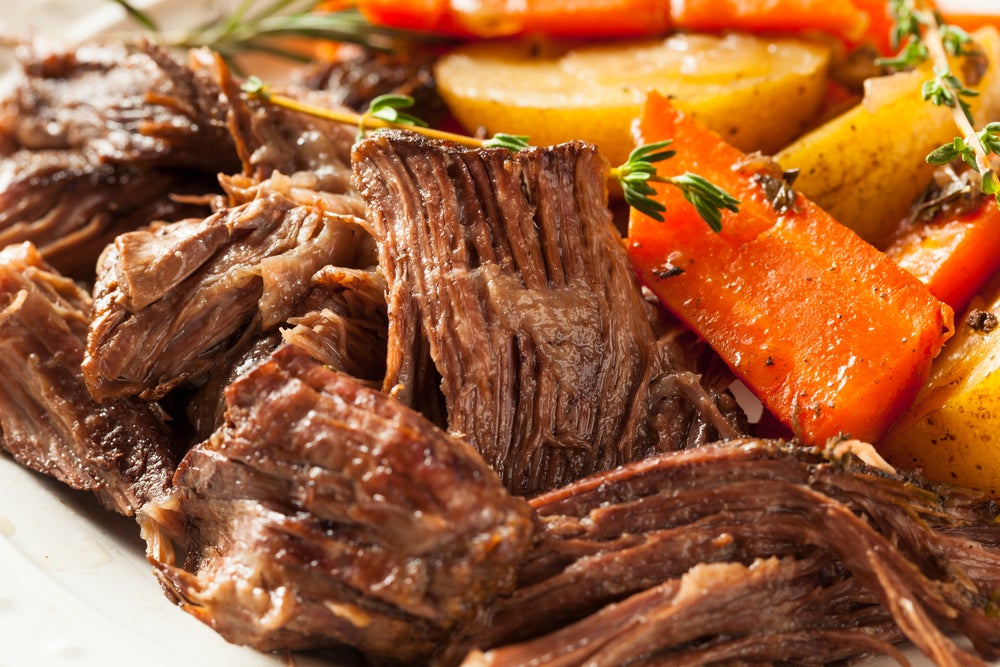
Recipe: Sous Vide Pot Roast
February 12, 2021
Roasts are a classic weekend to weekday meal - great on the day of and even better during the week for easy, thermos-ready lunches. Sous vide takes longer than a typical roast, but can be set up easily and left, mostly, unattended during the cook.
- Prep: 25 mins
- Cook: 20 hrs

Ingredients
1 lb chuck roast
2 medium carrots, split in half and cut into rough half moons
1 medium turnip, split in half and cut into rough half moons
4-6 small potatoes, or 1 large Yukon gold chopped into, cut into 1-inch cubes
2 sprigs rosemary
3 cloves of garlic, peeled
1 tbsp. vegetable oil for searing
2 tsp. Worcestershire sauce
1/2 cup ice (unless using a chambered vacuum sealer)
1/4 cup dry red wine
1/2 cup roughly chopped parsley to garnish
Directions
1Begin by setting your water bath to 170 degrees Fahrenheit, or 76 degrees Celsius
2Generously season your roast with salt and pepper - make sure to work the seasoning deeply into the roast.
3Combine the pot roast the carrots, potato, rosemary sprigs and Worcestershire sauce in a vacuum sealable bag, or using the water displacement method - add the ice too if you're not using a chambered unit and make sure to hit the 'moist' setting on your vacuum sealer.
4Cook the pot roast in the water bath for 24 hours, making sure to keep an eye on water evaporation if cooking uncovered.
5When the cook is done remove the pot roast from the water bath and pat dry the roast. Reserve the vegetables and cooking liquid separately.
6In a large skillet heat oil until shimmering. Add the beef and sear for 5-minutes per side. When searing the ends use your own discretion, but keep in mind that the roast will pull away without resistance when properly browned.
7Once browned remove the roast from the pan and bring 1/4 cup of wine to a simmer for about 1 minute.
8Add the reserved liquid and simmer until reduced by half, about 7 to 8 minutes for a thick sauce that easily coats the back of a spoon.
9Finally, re-add your vegetables and roast. Stir through until well coated in the sauce and serve over a bed of mashed potatoes or your favourite carbs.
8 Reviews
Doug
October 28, 2022
Made a huge batch of this for a gathering, came out really well despite lots of mistakes on my part. Very robust technique for making great pot roast.
Wanted to add to the earlier comments about cook temperature. 160 degrees F is the safe cooking temperature for beef. Below that, you’re in the “danger zone” unless refrigerated, and if meat has been in the danger zone for more than two cumulative hours, it is not safe to eat. When you cook a prime rib to 135 you’re in the zone, but only long enough to just cook and immediately serve and eat, so it’s slightly risky, but usually safe with good fresh meat. But if you cook at 135 for 12 or 24 hours, you’ll likely get very sick, or worse! This recipe cooks at 170 because that’s just a little bit above the minimum safe temp.
Andrew Wilson
January 30, 2022
Mark – The dish is a braise, so needs liquid for cooking, but when using a suction vacuum sealer too much liquid in the bag means liquid in the sealer and potential failure of the seal. The wine and worcestershire are pretty safe, given the overall size of the bag you’ll need, but there’s no reason to take chances with liquid water when you can add it in solid form. If you’ve ever needed to cool off a bowl of hot soup you have an idea how quickly ice will melt in the bath, so you’ll have the complete braising liquid for the majority of the cooking time.
Also, some folks freeze cubes of stock, so if you want to give it some extra flavor you could try that.
Mark
January 18, 2022
Why is ice added to the bag? Haven’t cooked yet so take 5 star rating with a gram of salt!
Lisa
January 16, 2022
Cooked exactly by directions. This was the most delicious pot roast I have ever made. I was beginning to question all the sous vide equipment I received for Christmas. It’s worth the counter space even if this roast is all I cook with it. Thank you so much for this recipe!
Carla
September 24, 2021
If you want it like prime rib cook at 136, if you want it more like a traditional well browned pot roast cook at 170
Kevin
September 20, 2021
All the other recipes I see online put the bath at around 135°. Has anyone tried this? 170° seems really high
Gary R
March 19, 2021
I needed a new recipe to try for our Pot Roast Sundays and this was a hit! So juicy and flavourful!

Paul
December 18, 2022
Commenting on Doug’s concerns about cooking temperatures. Doug is citing temperatures for conventional cooking methods where the the meat is done and safe to eat when it reaches a specified temperature for only an instant of time. “Instant kill” requires much higher temperatures than the long heat soak of the sous vide method. Sous vide Pasteurizes the meat at a much lower temperature than what is required for instant kill, with the side benefit of tenderizing the meat without overcooking it. This has been discussed to death everywhere sous vide is mentioned so I won’t repeat it here.
170 F is actually a very high sous vide temperature, and keeping it there for 24 hours would be overkill to just make the meat safe to eat. The purpose of it for this recipe is to make a tough chewy piece of chuck roast melt in your mouth without requiring the time and attention Grandma needed for doing it on top of the stove.